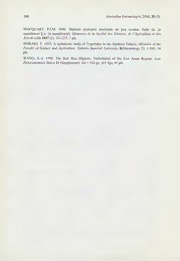
Three new larval food plants for the blue iris Skipper Mesodina cyanophracta Lower (Lepidoptera: Hesperiidae) PDF
Preview Three new larval food plants for the blue iris Skipper Mesodina cyanophracta Lower (Lepidoptera: Hesperiidae)
106 Australian Entomologist, 2008, 35 (3) MACQUART, P.J.M. 1848. Diptères exotiques nouveaux ou peu connus. Suite du 2e supplément [i.e. 3e supplément]. Mémoires de la Société des Sciences, de l'Agriculture et des Arts de Lille 1847 (2): 161-237, 7 pls. SHIRAKI, T. 1933. A systematic study of Trypetidae in the Japanese Empire. Memoirs of the Faculty of Science and Agriculture, Taihoku Imperial University 8(Entomology 2): 1-509, 14 pls. WANG, X.-J. 1998. The fruit flies (Diptera: Tephritidae) of the East Asian Region. Acta Zootaxonomica Sinica 21 (Supplement): viii + 338 pp, 265 figs, 41 pls. Australian Entomologist, 2008, 35 (3): 107-109 107 THREE NEW LARVAL FOOD PLANTS FOR THE BLUE IRIS SKIPPER MESODINA CYANOPHRACTA LOWER (LEPIDOPTERA: HESPERIIDAE) ANDREW A.E. WILLIAMS! and GRANT MILLER? 3 Department of Environment and Conservation, W.A. Wildlife Research Centre, PO Box 51, Wanneroo, WA 6065 2PO Box 336, Lennox Head, NSW 2478 Abstract Patersonia lanata R.Br., Patersonia umbrosa var. xanthina (F.Muell.) Domin and Patersonia juncea Lindl. (Iridaceae) are recorded as larval food plants for the blue iris skipper Mesodina cyanophracta Lower. Introduction The skipper genus Mesodina Meyrick is comprised of five species, all of which are endemic to the Australian faunal subregion (Braby 2000). The larval food plants for all of them are various species of Patersonia (Iridaceae). Prior to this paper, four of these species (Mesodina aeluropis Meyrick, M. gracillima Edwards, M. hayi Edwards & Graham and M. cyanophracta Lower) were each known to utilize only a single specific food plant. The other species, M. halyzia (Hewitson), has been recorded on P. fragilis, P. glabrata, P. occidentalis and P. sericea (Edwards 1958, Harslett 1965, Common and Waterhouse 1981, Braby 2000). Our recent observations show that the Western Australian M. cyanophracta also uses four species of Patersonia as food plants, the previously recorded P. occidentalis (Williams et al. 1993, Williams and Atkins 1996) plus three new records reported below. Voucher specimens pertinent to this paper are lodged in the Insect Collection of the Western Australian Department of Environment and Conservation (formerly Department of Conservation and Land Management [CALM]) and in Grant Miller9s private collection. New food plant records 1. Woolly Patersonia - Patersonia lanata In November 2000, a small population of P. lanata was located in Banksia attenuata woodland on a sandy hill overlooking the town of Bremer Bay in southwestern Western Australia (34°239S, 119°239E). An examination of the plants revealed characteristic wedge-shaped feeding scars on the leaves and shelters containing M. cyanophracta larvae. The larvae were collected and reared in captivity. As is often the case around Perth, a high proportion of the Bremer Bay larvae had been parasitised by a slender endoparasitic wasp (Hymenoptera: Ichneumonidae), which killed them in the final instar (Williams and Atkins 1996). At Bremer Bay and nearby Fitzgerald River National Park, adults of M. cyanophracta are on the wing in December (Williams and Williams 2006). 108 Australian Entomologist, 2008, 35 (3) Fig. 1. Mature M. cyanophracta larva feeding at leaf tip of Patersonia juncea. 2. Yellow Flag - Patersonia umbrosa var. xanthina First and second instar M. cyanophracta larvae were found on young P. umbrosa var. xanthina plants growing along a power-line cut immediately south of the town of Kirup (33°409S, 115°549E) in March 2002. They were transferred to potted food plant and reared in the warmer climate of northern New South Wales, adults emerging in late November and early December, suggesting a likely emergence in December or early January at Kirup. Parasitism by ichneumonids was in excess of 80%. Purple-flowered Patersonia, probably P. occidentalis, was also present in the same locality but showed no evidence of having been utilised by Mesodina. 3. Rush Leaved Patersonia - Patersonia juncea In April 2006 a single M. cyanophracta larva was found in a shelter on a P. juncea plant growing on Quinns Forest Block (33°08712=S, 117°04928=E), 25 km SSW of Narrogin. The larval food plant was potted and transferred to the Department of Environment and Conservation (DEC) Wildlife Research Centre at Woodvale for observation. The larva was inactive in April and May but commenced feeding in June, at which time it constructed a new, larger shelter by sewing together about 12 leaves of the food plant. The larva
